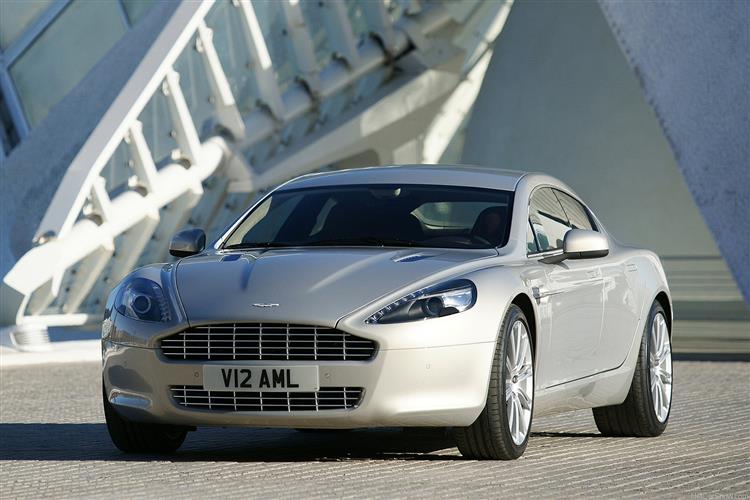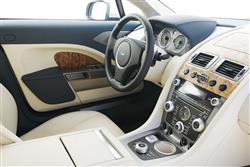This is a sample, and will stop after 30 seconds.
RAPIDE FIRE (some text hidden) SECTIONED_new_astonmartinrapides_2017_preview
By Jonathan Crouch
Introductionword count: 53
In the way that it drives as well as in the way that it looks, the four-door, four-seat Rapide, launched in 2010, set a new benchmark for Aston Martin. Hand built, luxuriously appointed and very pretty, it was desirable, expensive and very fast. Wherever you take it, more style per hour is guaranteed.
Modelsword count: 4
5-door GT [6.0 V12]
Historyword count: 316
What exactly, might the world's most elegant four-door sportscar be like? Design it in your mind. Or perhaps you'll allow us. A supercar badge, a storming V12 engine, pin-point handling and the sleekest possible shape that could disguise comfortable rear space for two and a decent boot. The car we've described is this one, Aston Martin's Rapide, launched in 2010 and the first four-door from this British brand since the Lagonda of the mid-1970s. That car went out of production in 1989, but Aston never gave up thinking about a replacement. Eventually, at the Detroit Auto Show in 2006, we saw the beginnings of one, the Rapide Concept, nominally a four-seater, in reality little more than a stretched coupe. More work was needed, four more years of it in fact, before the designers were able to release the Rapide we got four years later. It was still hardly a limo, but was probably as sensible as any Aston Martin is ever likely to get. As the company itself always pointed out, this was a sportscar first and foremost, with the added bonus of two extra doors. A claim we've heard before from cars like Porsche's Panamera and Maserati's Quattroporte. But cars not good enough for typical Rapide buyers with the kind of exclusive budget they'd normally invest in a Bentley. You already know from just glancing at this car that it's desirable. But will it work as a used buy? Time to see. Initial Rapide models were built for Aston by Magna Steyr in Austria but in 2011, the company moved production back to Gaydon to reduce costs. The car sold in standard form until 2013, then evolved into the Rapid S form we're focusing on here, with 81PS more and improved Touchtronic III transmission in late-2013. Special editions were launched in 2016 and 2019 and potent AMR variants were produced before production finished in 2021.
What You Getword count: 758
The Rapide is breathtakingly elegant in a way that you'd think would be impossible were it to be practical in any meaningful way. From the front, it sticks very much to established Aston Martin design themes first seen on the Vanquish and subsequently carried forward to DB9, DBS and Virage models. Get up close and beautiful detailing catches the eye, from the double-deck front grille and light tube sidelights that line the edge of the headlight clusters to the dramatic vent behind the front wheel arch, while extended creases along the coachwork deliver the long, low appearance that the stylists were clearly aiming at. It's all a far more beautiful solution to the problem of how to get four adults and their luggage into a sporting-looking car than that delivered by less exclusive four-door coupes from the period like Mercedes' CLS or Porsche's Panamera. But you'll be wanting to know the answer to the question everyone asks about this car. Is it a really a proper four-seater? The answer is yes, but it's a qualified one. To understand why, you first have to understand what this car is made of, an aluminium construction with a torsional stiffness better suited to two doors rather than four. To maintain it and keep those flowing lines in proportion, designer Marek Reichmann had to keep the rear doors on the small side, but in compensation, they are undoubtedly rather clever, with a 'swan wing' design that uses scissor hinges that enable them to open up and out at 12 degrees as well as outwards to an opening angle of 70 degrees, the whole process designed to protect the nine coats of paint applied to the Rapide's metalwork from high kerbs or verges. And of course to aid more dignified entry and exit, though ladies with skirts above the knee may find that to be rather a challenge. You do, after all have to negotiate a high, wide sill if you're to make it to one of the individually-sculpted sports seats which are separated by a wide centre console. Once you get there, despite an overall vehicle length of over five metres and a width of nearly two metres, it's all very snug - too snug probably if you're over six foot tall and sitting behind a front seat occupant of similar size. For us, it's just about OK and certainly fine for the kind of shorter journeys and airport hops that Aston say this car's rear compartment was really designed for. To be fair, there isn't the kind of claustrophobia here you might expect, thanks to race-style front seats which taper towards the headrests to give rear passengers a superb view ahead. The detailing is exquisite with hand-stitched leather, walnut and Iridium Silver detailing. At high speeds, the laminated windows even automatically move further up into their frames to improve refinement and each rear-seat passenger has an individual air-conditioning system to enhance comfort further. Move to the front and as you open the driver's door, there's a chance to appreciate what Aston Martin calls 'window choreography'. All four doors are frameless, with front and rear window panels meeting in the middle, each pane dropping a little when you pull the door handle before jinking sideways to allow you to enter. Once inside, everything is beautifully finished, from the metallic contra-rotating dial pack to the soft mood lighting and you've the familiar Aston mix of soft English leather and cool metal switches. There's no conventional gearstick, just large 'P', 'R', 'N' and 'D' buttons on the centre console. You'll get used to using these, but you may be disappointed to find that there are a few Ford bits scattered around. Existing Bentley owners won't be expecting to find indicator stalks from a Fiesta. The Volvo-sourced sat nav is a bit out of place too. We do though, like the Bang & Olufsen turrets that rise from the dash when you fire the engine and the way that the acoustic signature of the stereo changes when the rear seatbelts are used so that the whole car fills with sound, not just the front. Out back, it's a little surprising to find a hatchback rather than a boot, but provision of a fifth door is certainly a welcome extra aid to practicality, with 301-litres on offer and a pop-up bulkhead boot divider to help secure luggage. There are lovely touches like an umbrella in its own holder and at the touch of a button, the seatbacks fold down electronically to give a 750-litre luggage bay.
To see the full road test text contact us on 0330 0020 227
Pictures (high res disabled)

.jpg)
|
.jpg)
|
.jpg)
| |||
.jpg)
|
.jpg)
|
.jpg)
| |||
.jpg)
|
.jpg)
|
.jpg)
| |||
.jpg)
|

|
Scoring (subset of scores)
Category: Luxury Saloons and Estates
| Performance | |
| Handling | |
| Comfort | |
| Space | |
| Styling, Build, Value, Equipment, Depreciation, Handling, Insurance and Total scores are available with our full data feed. | |



